 An artist’s impression of a soliton microcomb device. [Brian Long, University of California, Santa Barbara, CA, USA]
An artist’s impression of a soliton microcomb device. [Brian Long, University of California, Santa Barbara, CA, USA]
Being able to measure the frequency of optical radiation is important for many scientists. It allows physicists to investigate whether or not fundamental constants of nature might be slowly changing over time, and has led metrologists to propose a new light-based definition of the second. But unlike the lower-frequency microwaves that serve as the basis for today’s SI unit of time, visible oscillations cannot simply be tracked using an electronic counter. They require what is in effect a piece of clockwork to link the visible portion of the electromagnetic spectrum to that of microwaves and radio waves.
The beauty of frequency combs lies in being able to calculate the value of an unknown optical frequency by measuring the pulses’ repetition rate, which lies at radio frequencies.
In decades past, researchers spanned this roughly five-orders-of-magnitude gap by using harmonics to join a series of progressively higher-frequency oscillators to one another—with the cesium microwave standard at one end and a specific visible transition at the other. But as Fritz Riehle of the PTB national metrology institute in Braunschweig, Germany, recalls, the “frequency chain” used by his group filled three laboratories in two different buildings and required hours of painstaking operation to precisely overlap the oscillations between successive links—ensuring that not a single cycle of radiation went missing.
Nowadays, a single mode-locked laser can do the same thing by generating a broad spectrum of very narrow and equally spaced optical frequencies whose values are determined using radio-frequency counters. Known as a frequency comb, this device has transformed metrology and initiated a race to build ever more stable and accurate optical clocks—requiring essentially just a single operator and an optical bench.
But researchers haven’t rested on their laurels. While commercial frequency combs rely on a laser smaller than a shoebox, a number of groups have gone on to develop comb generators made from cavities no more than a few millimeters across. These microcombs offer the prospect of generating and measuring optical frequencies using very cheap and compact devices that can be fabricated on a chip, potentially extending the application of frequency combs well beyond metrology and fundamental physics to areas such as telecommunications, spectroscopy and laser ranging.
Scientists are now close to integrating microcombs and pump lasers on the same photonic chip, and to producing such chips in large quantities using standard CMOS processes from the semiconductor industry. OSA Fellow Alexander Gaeta, an optical physicist at Columbia University in New York, USA, says that microcombs are still confined largely to research labs but reckons that “within five years, maybe less, you will start to see them in commercial devices.”
How radio measures the optical
In the time domain, mode-locked lasers produce a train of regularly spaced, ultrashort pulses. In the frequency domain, this results in hundreds of thousands of very narrow lines, or teeth, separated from one another by the (constant) pulse repetition rate, frep, and shifted slightly by a common offset, f0. The frequency of the nth line, fn, is therefore nfrep + f0.
Obtaining frep can be done simply by using a photodetector and electronic counter to measure the rate at which pulses are emitted. Establishing the value of f0 instead requires self-referencing, which means comparing teeth at opposite ends of an octave-spanning comb: fn and f2n. The trick is to frequency double the lower tooth and then generate beats between that and the higher one, given that 2fn − f2n = 2(nfrep + f0) − (2nfrep + f0) = f0.
With both frep and f0 measured electronically, the unknown frequency of another laser can then be worked out by interfering that beam with the comb pulses. This generates a radio-frequency beat note associated with each tooth in the comb (although only a few will be detected). Using a low-pass filter to isolate the lowest beat note, fb, the unknown frequency is then equal to nfrep + f0 +/− fb, the sign being set by shifting f0 and seeing if the beat note goes up or down.
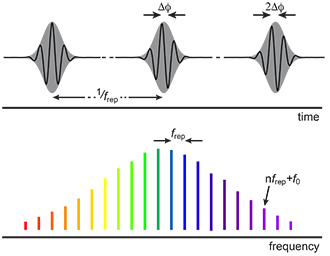
[N. Picqué and T.W. Hänsch, Opt. Photon. News, June 2019]
Pulses with teeth
The principle of mode locking was developed as far back as the mid-1960s, just a few years after the invention of the laser itself. It involves lining up the numerous modes from a broadband lasing medium—using a material whose loss varies with intensity—so that the waves constructively interfere. The result is an extremely brief pulse that bounces back and forth inside the laser cavity, and which leaks through a partially transmissive mirror once a cycle to generate a uniform train of pulses on the outside. Seen in the frequency domain, this continuous train of pulses consists of a series of fine and regularly spaced “teeth.”
The beauty of frequency combs lies in being able to calculate the value of an unknown optical frequency by measuring the pulses’ repetition rate, which lies at radio frequencies. However, their operation is complicated by dispersion in the laser cavity that causes the pulse envelope and carrier wave to move out of step. This calls for “self-referencing,” which generally requires that pulses span a full octave (see “How radio measures the optical,” right). Unfortunately, even broadband materials fall far short of this—widely used titanium-sapphire lasers, for example, span 30 THz (1 THz = 1012 Hz) but operate around 350 THz.
The breakthrough came at the end of the 1990s when groups led by OSA Honorary Members John Hall at the JILA research center in Boulder, CO, USA, and Theodor Hänsch at the Max Planck Institute for Quantum Optics in Garching, Germany, showed they could broaden a titanium-sapphire frequency comb to at least an octave by exploiting the optical nonlinearity of a photonic crystal. The same idea—which earned Hall and Hänsch a share of the 2005 Nobel prize in physics—was then employed in erbium-doped fiber combs, and these devices have since been commercialized by several companies.
Going micro
However, it is on the microscale that many researchers are now devoting their energies. Microcombs confine the output from a continuous-wave pump laser inside tiny resonators to enhance nonlinearities based on the Kerr effect—the variation of refractive index with light’s intensity. So-called whispering-gallery resonators can reduce the threshold for such nonlinearities to below a microwatt by using total internal reflection to confine the light around the circular or spherical perimeter of an air-dielectric interface—with resonances occurring when that distance corresponds to an integer number of wavelengths.
Resonators are generally made from dielectrics, with nonlinear interactions giving rise to the phenomenon of parametric four-wave mixing. This converts pump photons into sidebands that are equally spaced around the pump frequency. Given a cavity with a high enough quality factor, these sidebands can themselves stimulate parametric mixing and therefore further sidebands. This leads to the cascading generation of many equidistant sidebands—in other words, a frequency comb.
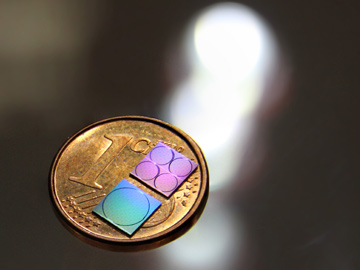 The silicon-nitride microresonator chip devices developed by Kippenberg and colleagues shown in comparison with a 1-cent Euro coin. [Jijun He and Junqiu Liu]
The silicon-nitride microresonator chip devices developed by Kippenberg and colleagues shown in comparison with a 1-cent Euro coin. [Jijun He and Junqiu Liu]
OSA Fellow Tobias Kippenberg and colleagues at the École Polytechnique Fédérale de Lausanne (EPFL) in Switzerland first reported having built this type of comb in 2007. Then six years later, the same group created a particularly efficient and low-noise type of microresonator, in which all of the cavity modes march in lockstep like those in a femtosecond laser to produce an isolated single pulse of light. Achieved through a careful balancing of nonlinearity and dispersion made possible by nanoscale lithography, the pulse that results is called a dissipative Kerr soliton.
“For many years the community was struggling along,” says OSA Fellow Scott Diddams of the U.S. National Institute of Standards and Technology (NIST) in Boulder. “We could do some things with these microcombs but the way we were operating them we weren’t getting the best out of them. Then the pieces all came together, including good theory and mastery of the technical details.”
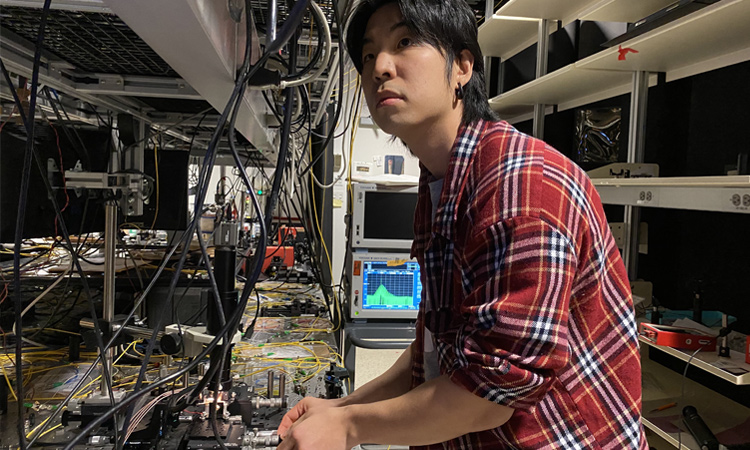 Jae Jang, Columbia University, aligns a microresonator comb. [Alexander Gaeta]
Jae Jang, Columbia University, aligns a microresonator comb. [Alexander Gaeta]
Joined at the chip
With soliton microcombs a reality, scientists have since been working to integrate these devices with very compact lasers. Following demonstrations with magnesium-fluoride microresonators by the U.S. company OEwaves and the Russian Quantum Center in Moscow, researchers at Columbia University including Gaeta and OSA Fellow Michal Lipson in 2018 showed how to do away with bulky and power-hungry external pump sources by exploiting the properties of silicon nitride. This insulating material is compatible with CMOS fabrication and has demonstrated quality factors in the tens of millions.
The Columbia device essentially consisted of two microchips bonded together. A III–V semiconductor amplifier served as the gain medium and one end of the laser cavity, while a silicon-nitride circuit contained the rest of the cavity and a 120-μm-radius microresonator. Measuring just 1 cm2 altogether (excluding control electronics) and attached to a standard AAA battery, the device required only 98 mW of electrical power to generate a soliton frequency comb.
Two years later, in 2020, a collaboration featuring Kippenberg, OSA Fellow John Bowers of the University of California, Santa Barbara (UCSB) and OSA Fellow Kerry Vahala of the California Institute of Technology (Caltech), USA, reported having made a “turnkey” device that coupled a chip containing a commercial distributed-feedback laser with another comprising several silicon-nitride resonators. By carefully selecting the laser injection current, chip separation and system temperature, the researchers avoided the need for complex tuning procedures and produced solitons simply by turning the pump laser on.
However, even this device took time to set up—requiring about two days to manually align laser and resonator as well as testing and packaging the system to ensure its parameters remained stable. Now, the EPFL and UCSB teams are applying CMOS processing to fabricate single chips in which a silicon and indium-phosphide substrate is bonded to a silicon-nitride substrate. The idea, according to Kippenberg’s EPFL colleague Junqiu Liu, is to make hundreds of chips from a single four-inch and potentially eight-inch wafer—allowing much faster, cheaper production.
Once the devices are in the hands of users, it should then become clear which applications have the most potential—and what the scale of the market might be.
Liu expects they will demonstrate the fabrication technology early this year, and reckons that “fierce” competition could then see the integrated package commercially available in the next two to five years—pointing out that several companies, including his group’s Ligentec, already sell stand-alone silicon-nitride chips. Once the devices are in the hands of users, he argues, it should then become clear which applications have the most potential—and what the scale of the market might be.
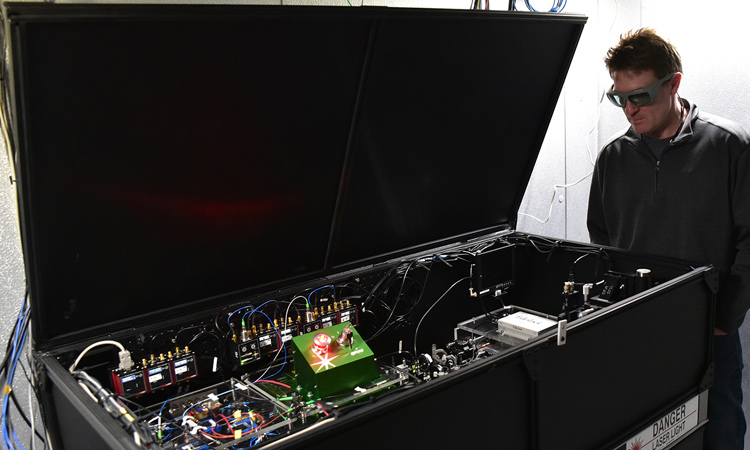 Scott Diddams views the NIST electro-optic frequency comb designed to ensure the precision of starlight analysis at the Hobby-Eberly Telescope in Texas. [NIST]
Scott Diddams views the NIST electro-optic frequency comb designed to ensure the precision of starlight analysis at the Hobby-Eberly Telescope in Texas. [NIST]
Broad benefits
Diddams points out that conventional mode-locked frequency combs have the advantage of being a very mature technology. As he puts it, “they just work.” But he says that the ability to integrate all components onto a single chip—and the consequent reduction in devices’ size, weight and power—could see combs being used far more widely.
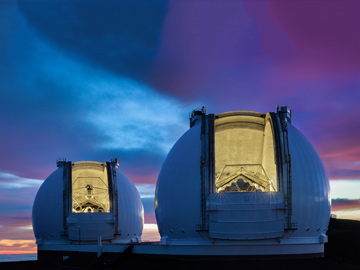 The W.M. Keck Observatory in Hawaii, used by Vahala and colleagues to show how a microcomb could be used to calibrate a near-infrared spectrometer. [Ethan Tweedie Photography/W. M. Keck Observatory]
The W.M. Keck Observatory in Hawaii, used by Vahala and colleagues to show how a microcomb could be used to calibrate a near-infrared spectrometer. [Ethan Tweedie Photography/W. M. Keck Observatory]
Combing the universe
In many areas of astronomy, wavelength precision is vital. Searching for extrasolar planets, for example, can be done by detecting tiny Doppler shifts in starlight caused by the star’s exoplanet-
induced wobble. According to Richard McCracken, a physicist at Heriot-Watt University, U.K., frequency combs could significantly expand the exoplanet haul by calibrating telescope spectrographs with velocity uncertainties of millimeters per second.
However, conventional mode-locked combs’ relatively narrow mode spacing of about 1 GHz cannot be resolved by spectrographs—leading to a bunching of comb lines that makes it impossible to identify a given wavelength. This can be avoided by filtering out most of the lines, but that fix can lead to unwanted frequency shifts.
Microcombs are potentially better suited, given their naturally broad line spacing.
Having been put through their paces on telescopes in the Canary Islands and Hawaii, microcombs could become attractive even to small observatories in the future, says McCracken, by virture of their size and price. But they have shortcomings, including being confined to the near-infrared and requiring an absolute frequency reference for extended observations. What’s more, exoplanet searches are currently limited not by the calibrators themselves but by difficulties in superimposing calibration lines and starlight.
OSA Fellow Thomas Udem, a physicist at the Max Planck Institute for Quantum Optics, Germany, believes this last hurdle will eventually be overcome via improvements to adaptive optics. “Dreaming a little further,” he says, it might then become possible to probe dark energy by using frequency combs to compare the velocity of distant objects at widely spaced intervals—without relying on theoretical assumptions such as spatial flatness. “It’s not completely crazy to think this could be done,” he says.
One particular selling point of microcombs, he adds, is their high repetition frequency. This rate—typically in the tens or hundreds of gigahertz—is dictated by the (very short) optical path length within microresonators. This in turn equates to a very wide spacing between the comb’s teeth, which, he points out, could help astronomers better calibrate spectrographs (see “Combing the universe,” right).
This wide mode spacing might also prove a boon in communications—with the many lasers currently used to multiplex data inside fiber cables being replaced by a single frequency comb (given that channels are typically spaced tens or hundreds of gigahertz apart). Indeed, in 2017, Kippenberg’s group, together with Christian Koos and other researchers at the Karlsruhe Institute of Technology in Germany, showed how soliton microcombs could be used to transmit data over dozens of different frequencies—spanning the C and L telecom bands—at more than 50 terabits per second. They also used a comb as a local oscillator to enable detection of multiplexed data.
One remaining obstacle, however, is efficiency. In the 2017 demonstration, less than 1% of the pump power ended up in the comb. Gaeta thinks this hurdle can be overcome, pointing out that a group led by Victor Torres-Company of Chalmers University in Sweden has since demonstrated an efficiency over 20% using a silicon-nitride microresonator that exhibited normal dispersion rather than soliton generation.
Indeed, Gaeta reckons that communications—either within data centers or high-performance computing systems—might be one of the first commercial applications of microcombs. Another, he says, could be spectroscopy. He suggests that portable comb-based spectrometers could be incorporated into smartphones within the next five to ten years—perhaps leading to as many as 100 million users monitoring their health via breath analysis.
Spectroscopy is in fact one of the most actively researched applications of frequency combs, according to Takuro Ideguchi of the University of Tokyo in Japan, particularly what is known as dual-comb spectroscopy. This involves combining two combs with very slightly different repetition rates and measuring their radio-frequency beats after they interact with a sample—the dips in the radio spectrum revealing the sample’s chemical makeup. The technique, he says, is quick, has good resolution and is accurate, having, for example, been used to sense greenhouse gases and other pollutants. Vahala and colleagues at Caltech showed in 2016 how dual-comb spectroscopy might be realized on-chip, when they demonstrated that a pair of soliton-based microcombs could reconstruct synthetic spectral profiles.
In search of the absolute
Each potential application of microcombs brings its own challenges—complexity being an issue with spectroscopy—but Diddams points out that these devices present another, more basic, hurdle: self-referencing. As he notes, microresonators that span a full octave already exist—he and some of his colleagues at NIST, led by OSA Fellow Kartik Srinivasan at the institute’s site in Gaithersburg, MD, having made one from a 46-μm-wide ring of silicon nitride. However, that comb’s teeth are separated from one another by 1 THz, a repetition rate too high to be counted electronically.
Working with their colleagues at UCSB, Caltech and EPFL, and supported by the Defense Advanced Research Projects Agency, the NIST group showed in 2017 how to combine the 1-THz octave-spanning waveguide resonator with a 3-mm-diameter silicon-dioxide wedge-based resonator. Having a 22-GHz repetition rate, they used this latter resonator to bridge the gap between the teeth of the former. Then, locking the combs to the output from a radio-frequency clock, they used them to create a very stable, precise optical frequency synthesizer by setting the frequency of a tunable III–V/silicon laser.
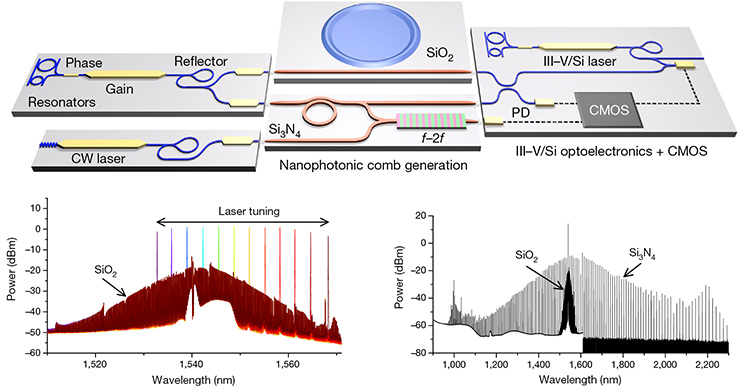 Researchers at NIST have created a chip-based optical frequency synthesizer based on two frequency combs (top). They used the combs to set the frequency of a tunable III-V/silicon laser, using the output from a silicon-dioxide resonator (bottom left) to bridge the gap between the wider-spaced teeth of a silicon nitride resonator (bottom right). [Reprinted by permission from Springer Nature: Spencer et al. Nature 557, 81 (2018).]
Researchers at NIST have created a chip-based optical frequency synthesizer based on two frequency combs (top). They used the combs to set the frequency of a tunable III-V/silicon laser, using the output from a silicon-dioxide resonator (bottom left) to bridge the gap between the wider-spaced teeth of a silicon nitride resonator (bottom right). [Reprinted by permission from Springer Nature: Spencer et al. Nature 557, 81 (2018).]
The NIST group later used the same technology to make a compact optical clock—the combs in that case serving as the counter for a semiconductor laser oscillator tied to an optical transition in trapped rubidium atoms. Despite this progress, however, Diddams says that the twin-comb system falls short of a truly integrated self-referenced microcomb—pointing out that it still needs elements housed off the chip, including an external pump laser.
“ The thing that is really hard to do is to self-reference microcombs in a package that is commensurate with micro. ”
—Scott Diddams, NIST
And there’s the rub. As Diddams points out, truly integrated self-referenced frequency combs would require a pump laser and microresonator, plus additional nonlinear components for octave generation and frequency doubling to be on the same chip. But he says that the need for sub-micron waveguides and a wide variation in refractive indices of the different materials involved makes assembly and low-loss operation real challenges. “The thing that is really hard to do is to self-reference microcombs in a package that is commensurate with micro,” he says.
In fact, Riehle at the PTB thinks that microcombs able to generate absolute frequencies might never see the light of day—given the expensive R&D that would be needed. He points out that wristwatches can already receive radio signals from cesium clocks that are accurate to at least one part in 1011. But he thinks that, unlike lab-based clocks, it would be overkill to push that uncertainty down by another four or five orders of magnitude. “It is simply not efficient to miniaturize a frequency comb if it is not needed,” he says.
Diddams, however, argues that microcombs without self-referencing could still prove competitive in a number of areas. While measuring absolute concentrations of carbon dioxide in the atmosphere would probably not be doable, he says, tracking temporal dynamics of biological systems such as folding proteins might be. Another possibility, he adds, is laser ranging that doesn’t involve absolute or very precise distances.
“The question of what you can do without self-referencing is an evolving one,” he says. “If you went back 20 years, it wouldn’t be a frequency comb if it wasn’t self-referenced. But now the thinking is changing a bit.”
Still, he believes that the technical challenges of full integration will be overcome, and that governments will provide the necessary funds—particularly given the military’s interest in such technologies. “It might take another 10 years,” he says, “but I am quite confident that it is going to happen.”
Edwin Cartlidge is a freelance science writer based in Rome, Italy.
References and Resources
-
M.-G. Suh et al. “Microresonator soliton dual-comb spectroscopy,” Science 354, 600 (2016).
-
D.T. Spencer et al. “An optical-frequency synthesizer using integrated photonics,” Nature 557, 81 (2018).
-
B. Stern et al. “Battery-operated integrated frequency comb generator,” Nature 562, 401 (2018).
-
A. Fülöp et al. “High-order coherent communications using modelocked dark-pulse Kerr combs from microresonators,” Nat. Commun. 9, 1598 (2018).
-
B. Shen et al. “Integrated turnkey soliton microcombs,” Nature 582, 365 (2020).
-
S.A. Diddams et al. “Optical frequency combs: Coherently uniting the electromagnetic spectrum,” Science 369, 267 (2020).
